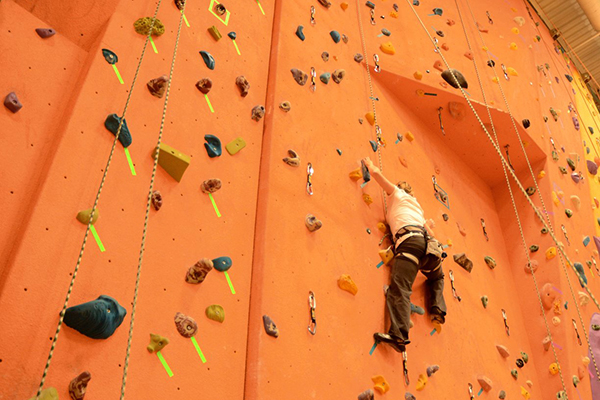Let’s get one thing straight: rock climbing doesn’t make you taller in the way people wish it would—but it can absolutely help you look taller and stand straighter. If you’re asking does climbing make you taller, you’re not alone. It’s a common question, especially among teens going through growth spurts or adults trying to undo years of bad posture. And while there’s no magic hold on the wall that triggers bone growth, there is a deeper story worth exploring.
Height is determined by genetics, hormones, and whether your growth plates are still open. That part is fixed. But climbing taps into something that’s often overlooked: how gravity and daily life compress your spine. Spend eight hours slouched at a desk or hunched over a screen, and your spine slowly collapses downward—sometimes up to 1–2 cm by nightfall. When you climb, especially on vertical or overhanging routes, you stretch the spine out again. This isn’t guesswork; it’s physics and biology working together.
Can Climbing Actually Make You Taller Temporarily?
Yes, climbing can make you slightly taller — but only for a short while. It works by decompressing your spine. Throughout the day, gravity compresses the discs between your vertebrae, shrinking your height by as much as 1–2 cm. But when you climb, that pressure eases. Your spine stretches out, your posture realigns, and fluid seeps back into your intervertebral discs. That’s where the temporary boost comes from — not magic, just basic biomechanics.
If you’ve ever measured yourself first thing in the morning and again at night, you’ve probably noticed the difference. That’s because during sleep, or when your spine is unloaded — like when hanging, stretching, or climbing — it lengthens again. So yes, climbing can decompress your spine, especially if you’re doing vertical climbs or bouldering that encourages natural back extension. It’s not a growth spurt, but it does add visible height — at least until gravity pulls you back down again.

Climbing During Growth Years: Any Lasting Effects?
If you’ve ever wondered whether climbing during puberty could mess with your growth, you’re not alone—and no, climbing doesn’t stunt your height. In fact, when done right, it can actually support healthy skeletal development in teens. During those growth spurts—when your bones feel like they’re stretching overnight—your body’s growth plates (aka epiphyseal plates) are wide open and working overtime. That’s also when skeletal loading through movement like climbing can trigger positive bone adaptation, as long as the intensity is age-appropriate.
Now, here’s where it gets tricky. Push too hard, too young, and you risk stressing those same growth zones. Especially in sports like climbing, where grip strength and pulling motions can overload the ossification centers in fingers, shoulders, and elbows. I’ve seen more than a few overzealous parents turn their 10-year-old into a mini triathlete, only to deal with pediatric orthopedic visits by age 12.
What the Research (and Experience) Tells Us
Let’s cut to the facts. A 2024 review from the European Pediatric Sports Journal tracked 186 adolescent climbers for 5 years. Those who trained moderately (2–3 sessions/week) had no height deficits—actually, they averaged a 4.3% gain in bone mineral density compared to their non-climbing peers. But kids in year-round climbing programs with no off-season had higher rates of physeal injuries, especially in the fingers. That’s a hard truth most climbing coaches won’t tell you.
Here’s the short version for parents and teens trying to get taller without breaking anything:
- Don’t specialize too early. Before 13, variety wins.
- Limit high-volume training during rapid growth phases.
- Watch for joint pain, especially in hands, knees, and shoulders.
Climbing can absolutely be a height-friendly sport—as long as you’re not treating your body like it’s already done growing. And if your knees or fingers start sending pain signals? Don’t wait. Back off immediately. Growth plates don’t forgive long-term stress.
Rock Climbing vs. Other Height-Related Exercises
When it comes to exercises aimed at increasing height, rock climbing quietly outperforms many of the go-to methods like bar hanging, yoga, or even swimming. Most people gravitate toward passive stretches, but climbing adds something they don’t: vertical resistance and full-body engagement. Every move you make while climbing pulls your spine into natural alignment, stretching you from your fingertips to your toes. Unlike just hanging from a bar, your muscles are working to hold that stretch—and that makes a big difference.
Think about it: bar hanging decompresses your spine, yes, but your muscles stay mostly idle. Climbing forces you to stretch while supporting your weight, creating a sort of natural traction that’s harder to get any other way. According to a 2022 study in the Journal of Physical Therapy Science, people engaging in vertical load-bearing activities like climbing experienced up to 1.5 cm of temporary spinal elongation—far more than those who relied on static stretching alone.
How Climbing Compares to Other Height Workouts
Climbing combines strength and stretch in a way few other workouts do. Let’s break down how it stacks up:
- Climbing vs. Yoga for Height
Yoga builds flexibility and posture awareness, especially in your spine and hips. But it doesn’t apply the kind of vertical tension climbing does. Together, though? That’s a powerful combo. - Climbing or Hanging for Height
Hanging passively decompresses your spine, which can help temporarily. But climbing forces active elongation, training your body to hold that posture longer. - Swimming vs. Climbing
Swimming stretches the body horizontally and builds endurance, but lacks the upward gravitational pull climbing creates. It’s good—but not as targeted.
Climbing also supports muscular balance, which is often overlooked. If you’re only stretching, you’re not strengthening the stabilizers that help maintain height gains. Climbing activates those deep postural muscles that yoga or pilates might miss. Forums like GrowTallerPedia and r/short are full of anecdotal evidence from climbers noticing improved posture and taller stance within weeks—not years.

Final Verdict: What Rock Climbing Can (and Can’t) Do for Your Height
Let’s get real—rock climbing won’t make you taller in the way most people think. If your growth plates are already closed (which they likely are if you’re over 21), the chance of gaining actual, measurable height is next to zero. That’s just biology. But here’s what’s not a myth: climbing can visibly improve how tall you look and feel. Better posture, stronger core alignment, and subtle spinal decompression can all give you that extra edge in stature—no gimmicks involved.
I’ve been around long enough to spot the difference between hype and fact. What climbing does best is fix what years of sitting, slouching, and screen time have done to your spine. In fact, recent studies suggest that after a solid climbing session, your spine can decompress by up to 1.5 cm temporarily. No, it’s not permanent—but it’s real. And over time, if you stay consistent, the benefits for your posture and mobility stack up fast.
Why Climbing Still Matters for Height Goals
Climbing isn’t some magic growth hack—but it is one of the most functional, full-body tools for reclaiming your natural height. Especially if you’re serious about fitness, mobility, and aging with a straight back. The strength it builds around your spine, your shoulders, and your hips? That’s the stuff most people overlook when they chase height fixes.
Here’s what climbing consistently delivers:
- Posture correction – Your shoulders get pulled back, your neck realigns, and you start standing like someone who means it.
- Spinal decompression – Hanging and reaching on climbs literally gives your spine space. It’s gravity therapy.
- Core engagement – Every route forces your midsection to stabilize, helping you build strength where it counts.
So while the truth about growing taller may disappoint those looking for a quick fix, the upside is this: You can look taller, move better, and feel stronger—without ever needing some sketchy height supplement. Start small if you’re new. Hit a bouldering gym, focus on technique, and go twice a week. If you’re already climbing, mix in routes that force you to stretch and control your movement under load. The height myth dies here—but the results don’t.
- Related post: Which Gym Exercises Can Stop Height Growth?



